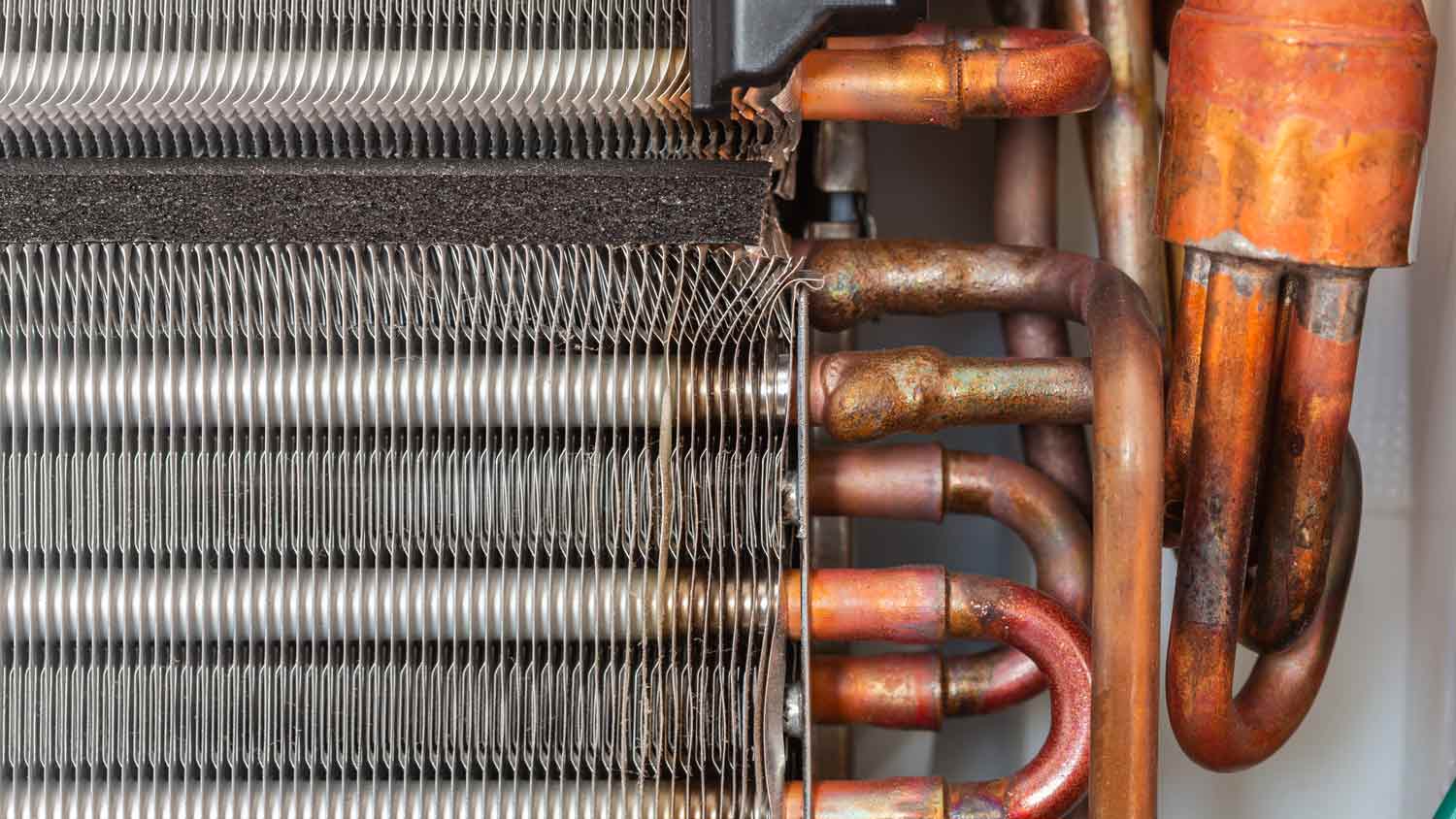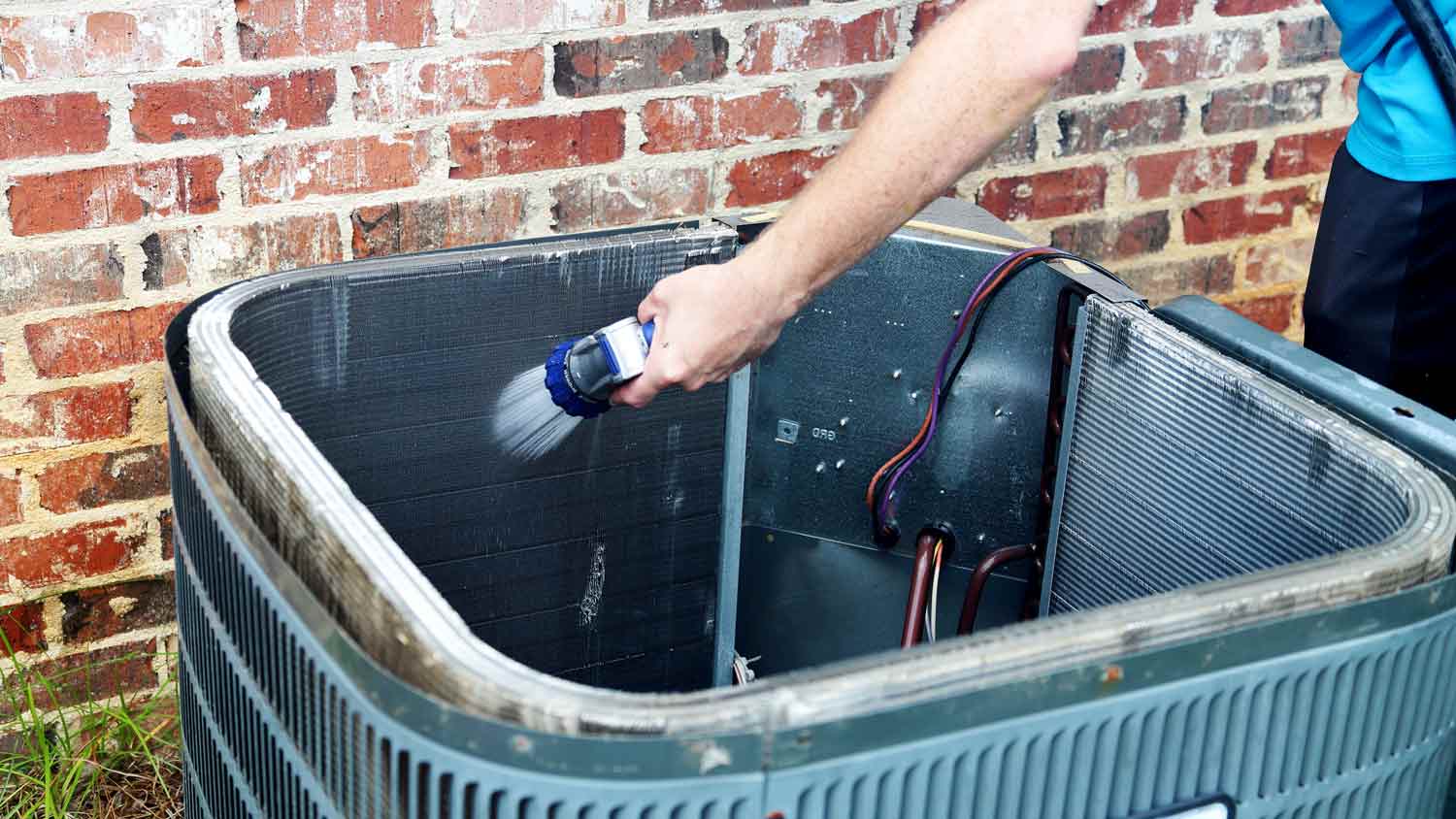Evaporator Coil vs. Condenser Coil: How to Tell the Difference
Compare and contrast the coils in your HVAC system


Evaporator coils absorb indoor heat, while condenser coils release it outdoors, completing the cooling cycle.
Evaporator coils are indoors near the blower fan, while condenser coils are situated outdoors within the outdoor unit.
Evaporator coils require regular cleaning to maintain airflow and cooling efficiency.
Condenser coils need even more frequent cleaning due to outdoor exposure.
Condenser coils and evaporator coils are two essential components of HVAC systems that serve distinct yet complementary functions. Understanding the difference between an evaporator coil vs. condenser coil is key for optimizing your system’s performance and troubleshooting issues with the help of a local HVAC repair technician. Let’s explore the differences that define these two crucial parts of your HVAC system.
What Are the Differences Between Evaporator Coils and Condenser Coils?

| Type of Difference | Evaporator Coils | Condenser Coils |
|---|---|---|
| Design | Compact coil | Coil with metal fins |
| Location | Indoors | Outdoors |
| Function | Absorb heat indoors | Send heat outside |
| Size | Smaller | Larger |
| Maintenance Needs | Regular cleaning | Frequent cleaning |
| Cost | $550–$1,100 | $900–$2,800 |
Evaporator Coil vs. Condenser Coil: Differences in Functionality
So, what is an evaporator coil and how does it differ from a condenser coil? An AC evaporator coil is designed to absorb heat and humidity from the surrounding environment. In contrast, the condenser coil works to release the heat absorbed from indoor air to the outdoor environment, completing the cooling cycle.
Design Differences
To absorb the heat from indoor air, the evaporator coil allows refrigerant to evaporate into a low-pressure gas state as it absorbs heat from passing air. This absorption of heat results in cooler air being circulated throughout the living space. Additionally, the evaporator coil plays a crucial role in dehumidification, condensing moisture from the air onto its surface as the refrigerant evaporates, contributing to a cool and comfortable indoor environment.
The condenser coil receives hot, high-pressure refrigerant gas from the compressor. As the refrigerant flows through the condenser coil, it undergoes a phase change, condensing into a liquid state and releasing heat into the surrounding outdoor air. This process allows the refrigerant to transition from a high-pressure gas to a liquid, preparing it for recirculation back into the evaporator coil to continue the cooling cycle.
Location Differences
The evaporator coil is typically situated indoors, housed with the air handler or furnace of the HVAC system. Its indoor placement allows it to be positioned near the blower fan, which draws warm air from inside of the building through the return ducts. This helps enable efficient circulation of indoor air over the coil for heat absorption.
In contrast, the condenser coil is located outdoors, placed within the outdoor unit of split types of air conditioner systems. Exposed to the outdoors, it can easily release heat into the surrounding air, which is essential to the cooling process. Having the condenser coil outdoors also helps prevent the buildup of hot air within the indoor living space.
Maintenance Differences

It’s crucial to keep both your evaporator coil and your condenser coil clean to maintain the efficiency of your HVAC system and prevent breakdowns and malfunctions. You can learn how to clean your AC coils yourself or invest in the cost of a professional AC coil cleaning to ensure your coils stay clean and free of debris.
Evaporator coils require regular cleaning to prevent problems from blocked airflow and reduced cooling efficiency. For example, a dirty evaporator coil is a possible cause for a heat pump freezing up, so it’s important to ensure it stays clean. On the other hand, maintenance of outdoor condenser coils should happen more frequently, as they’re exposed to outdoor elements and more prone to accumulating dirt and debris.
Cost Differences
Condenser coils are typically more expensive than evaporator coils. Replacing an evaporator coil costs anywhere from $550 to $1,100, while condenser coils usually cost between $900 and $2,800 to replace.
Frequently Asked Questions
While it’s possible to only replace an evaporator coil to keep your AC running, this could cause issues down the line. An AC system relies on the harmony between its condenser and evaporator coils for efficient operation. Replacing only one coil, especially in older units, can cause compatibility issues, leading to inefficiency and potential system breakdown.
As AC units near the end of their expected lifespan, investing in the cost for a new AC system is typically better than paying for individual component upgrades to avoid costly repairs and ensure optimal performance.
Signs of a damaged evaporator coil include warm air from vents, frequent starts and stops without proper cooling, failure to turn on, refrigerant leaks, and unusual noises. If you suspect issues with your AC system or its components, it’s best to call an AC repair technician for proper diagnosis and repairs.
Yes, having mismatched evaporator and condenser coils in your AC system can lead to serious issues. For instance, it can result in higher monthly energy costs as the system runs longer to compensate for the mismatch. This mismatch can also put extra stress on the system, compromising its efficiency and longevity.
Along with that, mismatched coils can lead to higher temperatures and humidity levels in the home. What’s more, using coils of different sizes may violate the manufacturer's warranty, as they are designed to work synergistically, and any mismatch could lead to repairs and system failure.
Unlike the condenser coil, the evaporator coil isn’t immediately visible from the outside. Instead, it is typically concealed within a metal box known as a plenum, which is positioned atop your furnace. In cases where a horizontal furnace is installed in an attic, the evaporator coil occupies one end of the furnace instead of being situated on top.





- Furnace Repair
- Air Conditioning Repair
- HVAC Repairs
- Furnace Installation
- Wood & Pellet Stove Repair
- Dehumidifier & Humidifier Repair
- Heat Pump Companies
- Swamp Cooler Repair
- Wood Stove Services
- HVAC Companies
- Commercial A/C Repair
- Geothermal Installation
- Air Conditioning Installation
- Boiler Repair
- 24 Hour Furnace Repair
- Geothermal Repair
- Heat Pump Repair
- Humidifier Installation
- Thermostat Repair
- Thermostat Installation
- Nest Installation
- Heating & Cooling
- Heating Repair
- Furnace Cleaning
- Furnace Tune-Up
- HVAC Technicians
- Subcontractors
- Furnace Maintenance
- Plumbing & Heating Companies
- Wood Stove Inspection
- Mini Split Installation
- Wall Heater Repair
- Duct Installers
- What Is an Evaporator Coil? Everything To Know About This Vital AC Component
- What Happens When an Evaporator Coil Gets Dirty?
- What to Do if Your Evaporator Coil Freezes: 6 Steps to Try
- All the Parts of an HVAC System Explained
- Why Is My AC Pan Full of Water? 5 Likely Culprits
- 7 Common Mini Split Low Refrigerant Symptoms and Signs
- How Does a Mini-Split Work?
- Heat Pump Not Blowing Hot Air? 7 Issues That May Be the Culprit
- Signs of AC Freon Leaks and What You Should Do
- Do Air Conditioners Use Water? They Don’t, So Here’s What That Puddle Is










